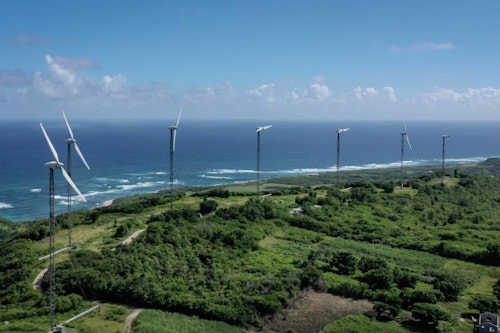The European Commission’s ‘Fit for 55’ package
On 15 July 2021, the European Commission published its ‘Fit for 55’ package as a road map for carbon neutrality.
Focus area
1 Act for energy transition
External link
Comprising 12 legislative proposals, it is aimed at accelerating the fight to combat climate change, achieving climate neutrality by 2050 and reducing greenhouse gas emissions by at least 55% by 2030 compared to those in 1990.
In the upcoming negotiations, the Energy Observer Foundation will be particularly focused within the France Hydrogène structure on everything that promotes and underpins the development of the hydrogen section and the necessary infrastructure, as well as the elevation of decarbonisation targets for the maritime sector.

Eoliennes à Marie Galante © Energy Observer Productions | Agathe Roullin
The 10 recommendations put forward by France Hydrogène
In this way, France Hydrogène has put together a list of 10 recommendations for improving the ‘Fit for 55’ package:
- Bring in clearer definitions for hydrogen, including a definition for low-carbon hydrogen with an emissions threshold that is in line with European taxonomy in relation to sustainable investments.
- Recognise the role of low-carbon hydrogen in meeting the European Union’s targets for reducing GHG emissions.
- Remove any obstacles to the production of renewable hydrogen by imposing a principle of adding to renewable energies, not on a single industrial sector, but on a Member State energy system level via national energy and climate plans (NECPs).
- Facilitate the allocation of free carbon quotas for electrolysis facilities, prior to the scheduled date of 2026 and for facilities producing more than 5 tH2/d.
- Guarantee an appropriate carbon methodology for imported hydrogen. In the event of integration in the CBAM, a minimum of scope 2 (indirect emissions) or even scope 3 (upstream phases and transport), shall be taken into account.
- Meet the target for decarbonisation of transport using low-carbon hydrogen, which should be eligible for the objective of - 13% GHG emissions in the sector in 2030, which can in turn be increased.
- Accelerate the roll out of hydrogen plants by bringing forward to 2025 the deadline left to Members States, while imposing a demographic criterion for the installation of plants in urban nodes.
- Mobilise all the sustainable fuels for the aviation and maritime sectors. Hydrogen and synthetic low-carbon fuels should be correctly taken into account in the ReFuelEU Aviation and FuelEU Maritime regulations.
- Make the taxation of hydrogen consistent over the long term by maintaining a favourable rate of taxation for low-carbon hydrogen after 2033 in view of environmental performance.
- Ensure sound structuring between the European legislation of hydrogen, particularly that between the ‘Fit for 55’ package and the package on gas and hydrogen.
Discover the entire stance by following the link.